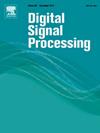A novel color image encryption algorithm based on infinite collapse map and hierarchical strategy
IF 2.9
3区 工程技术
Q2 ENGINEERING, ELECTRICAL & ELECTRONIC
引用次数: 0
Abstract
Chaos-based image encryption algorithms are important for information security, but current chaotic systems and encryption algorithms still have optimization potential. This paper proposes a novel one-dimensional improved composite chaotic map (1D-ICCM) to enhance chaos performance and the efficiency of generating chaotic sequences. The dynamic characteristics of the 1D-ICCM are analyzed in depth, demonstrating favorable chaotic properties. Based on this, we introduce a hierarchical strategy image encryption algorithm (HS-IEA) that combines 1D-ICCM and the Logistic map to improve the robustness and security of image encryption algorithms. The algorithm begins by integrating the image at the pixel level and performing secondary diffusion on the integrated sequence. After restoring the color channel matrices, the image is encrypted at the pixel level using bidirectional dynamic scrambling. Then, bit-plane decomposition is applied. To handle large amounts of data at the bit level, high-order and low-order bit planes are processed separately: high-order planes are encrypted using bit-level diffusion, while low-order planes use bit-plane rotation. Finally, the encrypted bit-planes and color channel matrices are merged for two-layer encryption. Experimental results and security evaluations confirm that the HS-IEA significantly improves image encryption's robustness, security, and performance.
一种基于无限折叠映射和分层策略的彩色图像加密算法
基于混沌的图像加密算法对信息安全具有重要意义,但目前的混沌系统和加密算法仍有优化潜力。为了提高混沌性能和生成混沌序列的效率,提出了一种新的一维改进复合混沌映射(1D-ICCM)。深入分析了1D-ICCM的动态特性,显示出良好的混沌特性。在此基础上,我们引入了一种结合1D-ICCM和Logistic映射的分层策略图像加密算法HS-IEA,以提高图像加密算法的鲁棒性和安全性。该算法首先在像素级对图像进行积分,并对积分序列进行二次扩散。在恢复颜色通道矩阵后,使用双向动态置乱在像素级对图像进行加密。然后,应用位平面分解。为了在位级处理大量数据,高阶和低阶位平面被分开处理:高阶平面使用位级扩散加密,而低阶平面使用位平面旋转。最后,对加密后的位平面和颜色通道矩阵进行合并,实现两层加密。实验结果和安全评估证实,HS-IEA显著提高了图像加密的鲁棒性、安全性和性能。
本文章由计算机程序翻译,如有差异,请以英文原文为准。
求助全文
约1分钟内获得全文
求助全文
来源期刊

Digital Signal Processing
工程技术-工程:电子与电气
CiteScore
5.30
自引率
17.20%
发文量
435
审稿时长
66 days
期刊介绍:
Digital Signal Processing: A Review Journal is one of the oldest and most established journals in the field of signal processing yet it aims to be the most innovative. The Journal invites top quality research articles at the frontiers of research in all aspects of signal processing. Our objective is to provide a platform for the publication of ground-breaking research in signal processing with both academic and industrial appeal.
The journal has a special emphasis on statistical signal processing methodology such as Bayesian signal processing, and encourages articles on emerging applications of signal processing such as:
• big data• machine learning• internet of things• information security• systems biology and computational biology,• financial time series analysis,• autonomous vehicles,• quantum computing,• neuromorphic engineering,• human-computer interaction and intelligent user interfaces,• environmental signal processing,• geophysical signal processing including seismic signal processing,• chemioinformatics and bioinformatics,• audio, visual and performance arts,• disaster management and prevention,• renewable energy,
 求助内容:
求助内容: 应助结果提醒方式:
应助结果提醒方式:


